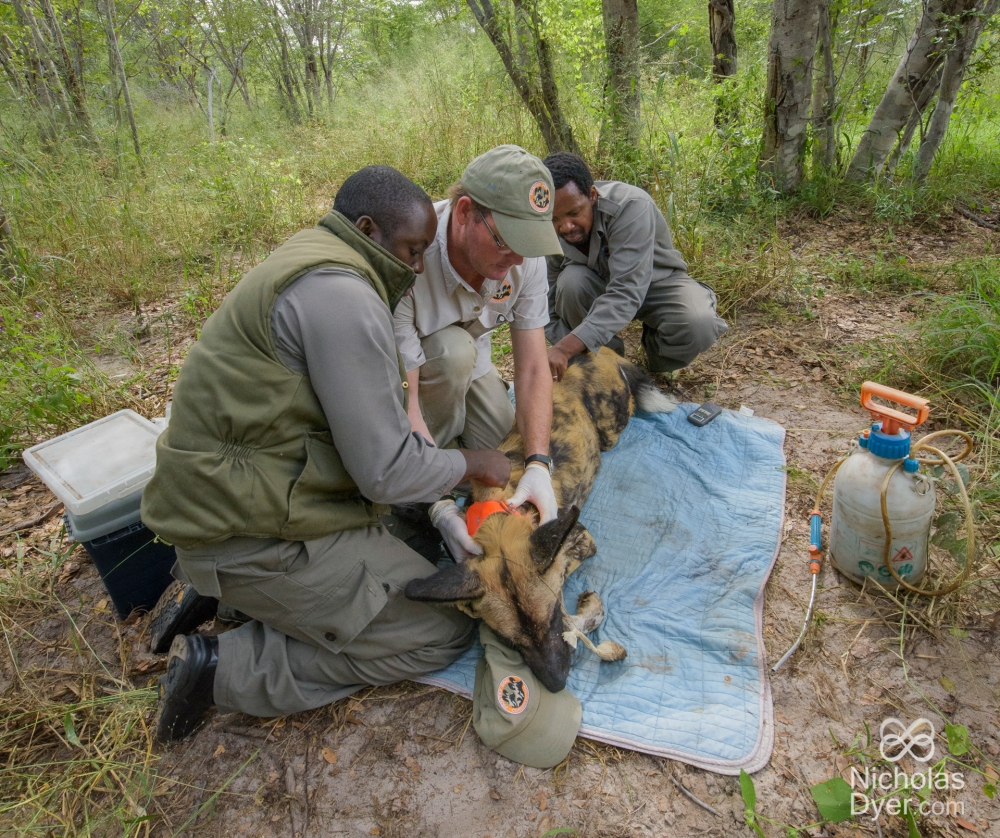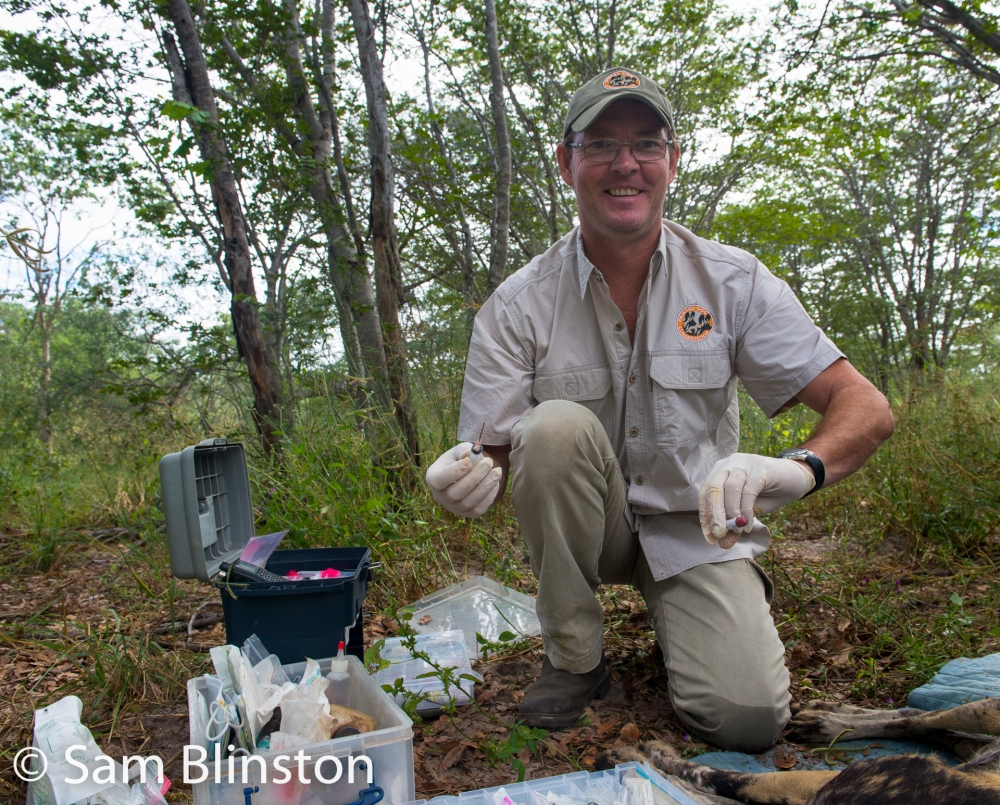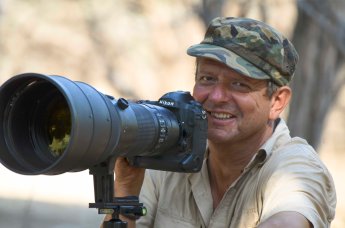
Collaring a member of a wild dog pack is an essential part of PDC’s work. Not only does the collar help them to monitor the pack and respond quickly to emergency situations, but their unique design warns motorists of a dogs’ presence in the road and helps a dog free itself should it get caught in a snare.
This is about a wild dog called Don, a male in the elusive Nyamandhlovu Pack and tells the story of what was involved in putting a collar on him last Friday morning.
Of all the Hwange packs that we follow at Painted Dog Conservation (PDC), perhaps the one with the widest range is the seven strong Nyamandhlovu Pack. Named after the pan where they where first seen, they regularly circle from there, down to Ngweshla Pan in the south and up to our centre in the north/west. An area of at least 800 square kilometres, both in and out of the park.
We had been trying to put a collar on one of these dogs for the last six months, but they are very much a now-you-see-them-now-you-don’t pack. Countless times we have been hot on their fluffy tails, only for them to disappear for weeks, and then reappear again many kilometres away in a totally different area of the park. Many early morning searches and endless frustrating hours have been devoted to this task, none of them successful.
So it was not without excitement to hear that Fanuel and Washington had found the pack last Friday morning and had successfully tracked the dogs to where they came to rest…conveniently by the side of the tarmac road on the way to Hwange Main Camp.
On receiving the report, Peter hastily abandoned his cornflakes and set off for another hopeful attempt to put a collar on one of the dogs. Having just arrived back at PDC, I hastily unpacked my camera gear and rushed to follow in my vehicle, still in flip-fops and desperately hoping that my camera batteries were still reasonably charged.

We arrived to find the dogs lounging nonchalantly in the middle of the road. Fanuel and Washington were monitoring them from a distance. It was a relief to see that the dogs’ bellies were not full, since, if they had just eaten, it would simply be too dangerous to attempt to dart one.
Peter quickly loaded his dart gun and drove in towards them slowly. As is typical of the Nyamandhlovu, just as he drew close, they started to move towards the dense trees. It was starting to look like yet another of those frustrating ‘close, but no cigar’ experiences.
Suddenly, one of the males called Don turned around inquisitively to look at Peter, who was by now leaning out the window, dart gun at the ready. There was the briefest of opportunities and Peter took the shot, backed by the experience and confidence of countless darting encounters.
The dart hit Don’s hindquarters perfectly square. He yelped and disappeared into the trees with the rest of the pack. We lost site of them almost immediately, but had to wait patiently in our vehicles for the drug to take effect before we could follow. The last thing we wanted was to chase a tranquillised dog that would be woozily looking for a quiet place to lie down and pass out.
After about five minutes, the four of us moved into the forest on foot and fanned out to search for Don, the darted dog. The cover was dense and it was not going to be an easy task to find him.
An occasional deep growl came out of the bush which signalled that one of us had come close to the rest of the pack and they were letting us know that getting any closer was unwelcome.

Eventually, I found Don huddled in some thick grass not far from the cars. I signalled to the guys and quietly indicated that I had located him and stood by the snoozing pooch while they collected their equipment from the vehicles.
As I waited, I crouched and stroked his soft fur and it struck me what excellent condition he was in; something that everyone else commented on during the collaring exercise.
It was heart-warming to see such a healthy looking creature in his prime. In the distance, I could hear another dog hoo-calling, wondering what had become of his seemingly lost mate.

The others returned with all the necessary kit for the operation. Fanuel and Washington lifted Don gently onto a blanket and carried him to a more open area in which to work in.

Peter inserted some earplugs into Don’s large Mickey Mouse ears, as they remain sensitive to sound, despite the tranquilliser. As do his eyes, which we covered with my purloined PDC cap.

Peter, Washington and Fanuel set to work in a well-practised routine, each knowing the crucial role they had to play. Critical was monitoring and controlling Don’s temperature, as the drugs inhibit his natural ability to maintain the correct level. A thermometer was inserted into his bum and water was periodically poured over him to keep him cool.

Peter fitted the specially designed collar around Don’s neck, ensuring that it was not so tight that it irritates or too loose that it falls off in the rough and tumble of everyday dog life. Before doing so, he made sure that he could pick up the collar’s VHF signal on his receiver. Little is more irritating than to fit a collar, only to find out later that it was faulty.

Peter took blood and tissue samples which will be sent to the US for analysis. This is very much routine, and forms an essential part of the continuing research that PDC carries out on painted dogs. He also gave Don a syringe full of healthy vitamins to strengthen his immune system and help him recover from the affects of the anaesthetic.

From time to time, Don was gently turned over in order to further reduce the risk of him overheating and to relieve any build up of pressure on any one side.

What was nice to watch was the calmness and efficiency of the operation. It was clear that Peter, Washington and Fanuel knew exactly what their roles were and worked seamlessly with a strong sense of camaraderie. While focused, they remained relaxed and even managed a few jokes amongst themselves. Clearly they were very happy that at last they had managed to get a collar on a dog from the elusive Nyamandhlovu Pack.
Furthermore, you could see that they cared deeply about the welfare of the animal and the species as a whole. It was clear that for all of them, this was a vocation and not just a job.

It was also a pleasure to have nine-year-old Sam Blinston along with us, who has witnessed his father darting dogs throughout his life. He has now reached an age where he too can lend a useful hand and seemed to know exactly what to do.

This included taking control of one of my cameras and capturing this cracking shot of his father hard at work.

The operation thus far was a success and had taken about 45 minutes. It was time to put everything away and clear an area for the dog to wake quietly up in.
Don was left lying alone on his blue blanket and Peter administered the reversal drug that counters the effect of the tranquilliser. We moved back some distance to allow Don to wake up slowly and in peace. I returned to the car to fetch my longer lens.

After about five minutes, a dog’s head lifted out of the tall grass looking bemused and uncertain. He looked around and saw me in the distance, despite half hiding behind a tree. He lay there staring at me for over minute, trying to gather his wits, wide eyed and not quite with it.

Eventually, he dragged himself to his feet uncertainly, stumbling around and struggling to keep his balance. It is never nice to watch this part of the operation as they clumsily stagger about. Fortunately the recovery process does not last too long and their movements helps to push the drug out of their system. Don was a healthy strong dog and before long he had gained is composure.

As we crouched down in the tall grass watching him, Don turned to face us. I doubt very much that it was with any sense of gratitude, as I suspect he had a thumping headache and still felt quite disorientated.
But he now had a collar which meant we could more easily find the Nyamandhlovu Pack if any member got injured or snared. Being able to locate an elusive pack like this one can potentially save one of the dogs from a life-threatening situation.
He now had a collar with a florescent orange reflector. The colour has little impact on the dogs, but as they love to lie in the middle of main roads, these reflectors have saved the lives of countless dogs from unaware motorists. Road kills are a major threat to the painted dogs and now the Nyamandhlovu had some form of protection.
And he now had a collar with an anti-snare guard to protect his throat. These specially designed collars give a dog a fighting chance if they get caught in a wire snare and help them to break free.
So no, maybe he was not that happy with being darted, but we were relieved that we had at last been able to offer Don and his Nyamandhlovu Pack some protection from the threats that they continually face.
Don continued to stare at us for a little while longer. Steadier on his feet by now, he slowly turned and walked away into the thick forest, gradually disappearing from sight. He was heading in the direction that we last saw the rest of his pack and from where the hoo-calling had earlier echoed hauntingly through the trees.
Our job done, we stood up to return to our vehicles and head back to base. Peter still had his soggy cornflakes to look forward to.

…………………………………………………………………………………………………………………..

Nick Dyer
Nick is a wildlife photographer who lives a nomadic lifestyle exploring eastern and southern Africa. Nick’s passion for wildlife and photography began when growing up in Kenya. On leaving Kenya he worked in London as a fund manager and subsequently ran a successful marketing business after taking a career break to journey across every roadless desert in Australia. He returned to Africa in 2012 to live his dream of full time photography and satisfy his lust for adventure. He now uses his photography, writing and business experience to make a difference where he can and has a particular passion for wild dogs.
Painted Dog Conservation
African wild dogs (also know as painted dogs) once ranged across Africa, with a population of over 500,000 in 39 countries. Impacted by poaching, road kills, and loss of habitat, only 6,600 dogs are now thought to remain on the whole continent. Zimbabwe, where Painted Dog Conservation (PDC) is headquartered, is one of their last strongholds.
PDC is dedicated to reversing this decline and the real threat of extinction. Our main operations take place in and around Hwange National Park as well as in Mana Pools National Park.
Here we have extensive and established programmes focused on:
- Community education
- Anti-poaching
- Primary research
- Pack monitoring
- Dog rescue and rehabilitation
Each programme is making a real difference to the wild dog’s chances of survival and we are grateful for every donation we receive to support our work.
Please visit our website to find out more.

congrats to you all….you have save this rare species and God reward abudantly….if I ask what is need for taking blood from the dog
LikeLike
Thanks for you supportive message Ahmad. PDC takes a blood sample from the dog as part of a collaboration with Stamford University in the USA. We are attempting to sequence the Wild Dog genome which will held us to gain an understanding of the genetic concentration in parks like Mana Pools and Hwange as well as the genetic diversity across the rest of Zimbabwe and Africa. This understanding will help support decisions going forward which is critical as the species is in serious decline with less than 7,000 wild dogs left in Africa.
LikeLike
Beautiful story and a nice bit of hope to see a young conservationist learning the ropes with his dad. The new collar looks sturdier and more protective. What is the cost of these in US dollars?
LikeLike